Prey utilization by Neptunea arthritica (Caenogastropoda: Buccinidae): predation on gastropods and size-related variation
IF 1.2
4区 生物学
Q2 MARINE & FRESHWATER BIOLOGY
引用次数: 4
Abstract
The whelk Neptunea arthritica (Buccinidae) is a common fishery species in Hokkaido, northern Japan. Although ecological information is needed for fisheries management, there is only one paper examining the foraging ecology of this species and it reported that N. arthritica preyed mainly on the invasive mussel Mytilus galloprovincialis. To date, no studies have examined utilization of native prey species by this whelk. Here, we report the findings of a study on the native prey utilization by N. arthritica in an area where M. galloprovincialis is not present. We conducted line transect sampling every month from May 2018 to May 2019 on the western coast of Hakodate Bay, southwestern Hokkaido, Japan. Prey items were composed mostly of gastropods (72%), followed by bivalves (24%) and only a small amount of carrion (<4%). Overlapping spatial distributions were observed among size classes of N. arthritica, while the prey utilization varied with body size. Small individuals (<30 mm in shell height) preyed mainly on the small colloniid gastropod Homalopoma sangarense, while larger individuals (>40 mm) preyed mainly on two tegulid gastropods (Chlorostoma lischkei and Omphalius rusticus) and two venerid bivalves (Protothaca euglypta and Ruditapes philippinarum). There were positive size relationships between whelk body size and prey size for prey categories (Vetigastropoda, Caenogastropoda and Bivalvia) and even for the same prey species (H. sangarense, O. rusticus and P. euglypta). These results suggest that N. arthritica is a predator of mobile gastropods, especially during its early life stage, in areas without the invasive Mediterranean mussel. It is possible that the foraging strategy of N. arthritica may differ quite markedly between areas with and without the invasive mussel.海参对猎物的利用:对腹足动物的捕食和大小相关的变化
关节炎海螺是日本北部北海道的一种常见渔业物种。尽管渔业管理需要生态信息,但只有一篇论文研究了该物种的觅食生态,据报道,关节炎N.arthritica主要捕食入侵贻贝Mytilus galloprovincialis。到目前为止,还没有研究检测这种海螺对本地猎物的利用。在这里,我们报道了一项关于关节炎N.arthritica在不存在M.galloprovincialis的地区利用本地猎物的研究结果。从2018年5月到2019年5月,我们每月在日本北海道西南部函馆湾西海岸进行横断面采样。猎物主要由腹足类(72%)组成,其次是双壳类(24%),只有少量腐肉(40毫米),主要捕食两种被盖腹足纲动物(Chloromoto lischkei和Omphalus rusticus)和两种性病双壳类动物(Prototaca euglypta和Ruditapes philippinarum)。对于猎物类别(Vetigastrododa、Caeno腹足目和双壳目),甚至对于相同的猎物物种(H.sangarense、O.rusticus和P.euglypta),海螺的体型与猎物大小之间存在正相关关系。这些结果表明,关节炎猪笼草是流动腹足类的捕食者,尤其是在其生命早期,在没有入侵地中海贻贝的地区。关节炎N.arthritica的觅食策略可能在有入侵贻贝和没有入侵贻贝的地区之间存在显著差异。
本文章由计算机程序翻译,如有差异,请以英文原文为准。
求助全文
约1分钟内获得全文
求助全文
来源期刊

Journal of Molluscan Studies
生物-动物学
CiteScore
3.00
自引率
8.30%
发文量
36
审稿时长
3 months
期刊介绍:
The Journal of Molluscan Studies accepts papers on all aspects of the study of molluscs. These include systematics, molecular genetics, palaeontology, ecology, evolution, and physiology. Where the topic is in a specialized field (e.g. parasitology, neurobiology, biochemistry, molecular biology), submissions will still be accepted as long as the mollusc is the principal focus of the study, and not incidental or simply a convenient experimental animal. Papers with a focus on fisheries biology, aquaculture, and control of molluscan pests will be accepted only if they include significant advances in molluscan biology. While systematic papers are encouraged, descriptions of single new taxa will only be considered if they include some ‘added value’, for example in the form of new information on anatomy or distribution, or if they are presented in the context of a systematic revision or phylogenetic analysis of the group.
 求助内容:
求助内容: 应助结果提醒方式:
应助结果提醒方式:


